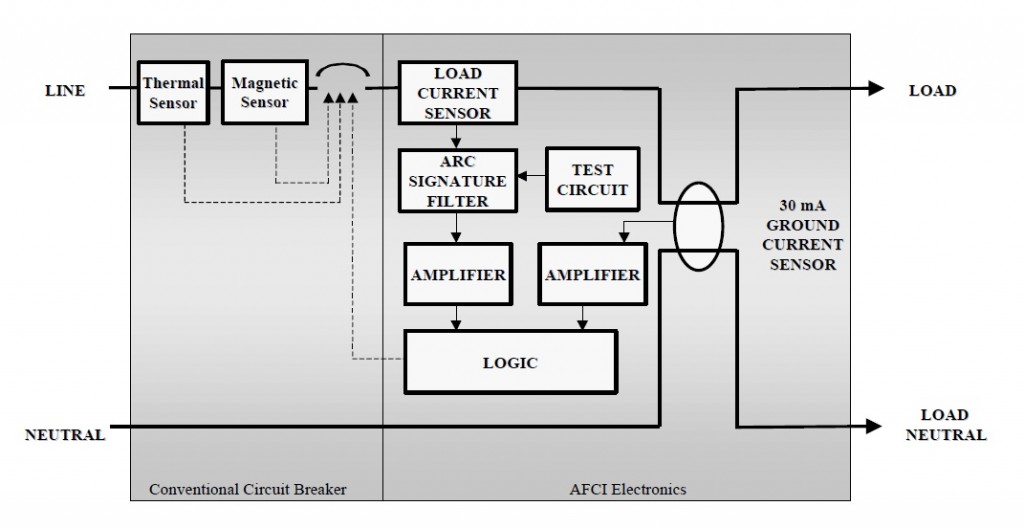 Meet the Arc Fault Circuit Interrupter
Meet the Arc Fault Circuit Interrupter
 You are probably familiar with the Ground Fault Circuit Interrupter (GFCI), also called Ground Fault Interrupter (GFI), Residual-Current Device (RCD) and a few other names. While doing some electrical work for a family member, I discovered Arc Fault Circuit Interrupters (AFCIs) in the breaker box. Having a genuine Electrical Engineering degree (two, actually), I’d like to believe that I am reasonably up to date on basic house wiring. But somehow AFCIs had escaped my attention, even though they started appearing in the National Electric Code over 10 years ago.
You are probably familiar with the Ground Fault Circuit Interrupter (GFCI), also called Ground Fault Interrupter (GFI), Residual-Current Device (RCD) and a few other names. While doing some electrical work for a family member, I discovered Arc Fault Circuit Interrupters (AFCIs) in the breaker box. Having a genuine Electrical Engineering degree (two, actually), I’d like to believe that I am reasonably up to date on basic house wiring. But somehow AFCIs had escaped my attention, even though they started appearing in the National Electric Code over 10 years ago.
A bit of searching on the internet revealed that these newfangled devices are intended to detect arc faults are below the trip level of a normal circuit breaker. Think in terms of a frayed extension cord that arcs over, creating a fire hazard, but not exceeding the 15 ampere rating of a typical house circuit. As usual, the Wikipedia entry is a good place to start. AFCIs detect arcs by monitoring the current behavior throughout the 60 Hz cycle. There are characteristics in the waveform that indicate an arc condition exists, causing the AFCI to disconnect the circuit. This article goes into more technical detail if you are interested:
New Technology for Preventing Residential Electrical Fires: Arc-Fault Circuit Interrupters (AFCIs)
Just like GFIs, AFCIs are available for installation in the main breaker panel and for installation at the electrical outlet. The diagram below shows the block diagram of a typical single-phase AFCI. This is not your old school circuit breaker but a complex system that performs both arc and ground fault detection. As already mentioned, the arc detection is performed by sensing the current behavior. The ground fault detection senses the difference between the current leaving and returning to the device. If there is a significant mismatch between the two currents, a ground fault has occurred.

From “New Technology for Preventing Residential Electrical Fires: Arc-Fault Circuit Interrupters (AFCIs)”
This post is just a quick introduction to AFCIs, with a USA perspective. Your local building codes are now or will soon be requiring AFCIs on new construction, so you’ll probably encounter them sooner or later. The National Electrical Manufacturers Association has a website with additional information: www.afcisafety.org.
73, Bob K0NR
The post Meet the Arc Fault Circuit Interrupter appeared first on The KØNR Radio Site.














These demonic devices have been causing havoc to unsuspecting amateurs for several years now. I have basically given up amateur radio because of them. There is quite a bit of information on these available at the following e-ham forum.
http://www.eham.net/ehamforum/smf/index.php/topic,96949.0.html
If you have these devices good luck in resolving the issues with them.
Best 73,
Terry, W4TL
I have heard of these. A friend was selling his house and the potential buyer hired an inspector to go over the house. The inspector came up with a big list (of course) and one thing on the list was that all circuit breakers had to be replaced with arc faults. Is that true??
I think only areas like bedrooms. Our house is 10 years old, and those are the only places that have them. No problems. More problems with the RF from the xmitter causing lights to flash in XYL’s china cabinet with the touch switch, and having me need to re-boot the garage door opener from time to time. Ferrite chokes are your friend…
It all depends on your local building code. The new National Electric Code requires them for most circuits in a new home. My home was built in late 2013 and I have a total of 18 of these troublesome devices in my electrical panel. I can assure you that the majority of them will trip with as little as 5 watts output when you are operating on the HF bands. You will also trip your neighbors AFCI’s within a 400 to 500 foot radius of your station too. What a nice way to meet all of your neighbors.
We just completed our dream house in June. I was so excited to get my rig operational in my new ham room (can’t call this one a ‘shack’!). The excitement quickly turned into a nightmare when I started tripping my Eaton AFCI and AF/GF circuit interrupters whenever I got on the air, especially on the 20 – 10 meter bands. I am even tripping Eaton’s AF/GF circuit interrupters; even though, Joe Fellos at Eaton told me I was the first one to have ever reported hams tripping their AF/GF circuit interrupters. He admitted problems with their AFCI breakers, but said they had never heard of anyone having problems with their AF/GF circuit interrupters. Joe Fellos seems to be sincerely interested in helping resolve this problem, but so far, it has just been all talk and no action. I am extremely frustrated over this Enormous impediment to my ham radio activities.